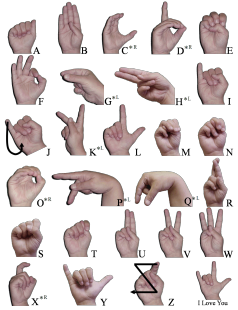ASL: What You Need to Know to Get Fluent and Get a Job


Interest in American Sign Language is growing thanks to viral videos like this one of ASL interpreter Tina Cleveland and her fiance roadtrip jamming to “You’re The One That I Want” from Grease and this one of kindergartener Claire Koch signing her Christmas concert for her deaf parents. As ASL interpretation becomes more and more common at events, including political rallies and speeches, concerts (check out these ASL interpreters’ mad skills!), and conventions/conferences, more and more people are becoming aware of the need for interpreters. However, not everyone is familiar with what interpreters do, how to learn ASL, or the history behind the language and profession.
Career Growth and Responsibilities
A couple weeks ago, we profiled interpreters and translators as part of our Fastest Growing Jobs in America series. This career (including both translators, those who work with the written word, and interpreters, who work with spoken language and sign language) is projected to grow 46.1% between 2012 and 2022. If you’re interested in a career in ASL interpretation (or are interesting in learning the language for your own personal development or to communicate with friends and coworkers), it is important to understand the history behind the language and the modern Deaf culture. Your ASL training must include these elements, not just a simple explanation of fingerspelling.
Anywhere Deaf and non-ASL speaking people interact is a good place for an interpreter. Interpreters work both in small groups or individual interactions and in front of crowds. They may interpret a professional conference call or aid someone attending a conference on an individual level. Recently, Startup Weekend held a special event called Startup Weekend Access. We had several Deaf attendees and had a rotating lineup of awesome and talented interpreters available to all attendees for individual help and to interpret each speaker. There’s a wide range of opportunities available to ASL interpreters...you’re sure to find your niche!
Brief History
Deaf Culture
Deaf culture has evolved over time to become more than a group of individuals who share a “disability;” in fact, many Deaf individuals consider being deaf a shared and community-based experience and resist clinical disability labels. Involving yourself in the Deaf community and culture is an important step in relating to and communicating with those who are deaf. Get out in the community and experience ASL events! My aunt participates in Silent Weekend to practice her ASL. Find a local Silent Weekend in your community. Even theatre is an option; Deaf West Theatre is producing their own version of the Tony Award-winning musical Spring Awakening with a cast of Deaf, hard of hearing, and hearing actors.
Ready to get your ASL learning started? Try the American Sign Language Introduction by CompuWorks. You’ll get an in-depth history of ASL and an overview of modern Deaf culture, along with a solid basic training in ASL. Let us know what you think and share additional resources in the comments.
Image Credit: By Cwterp (Own work) [Public domain], via Wikimedia Commons



